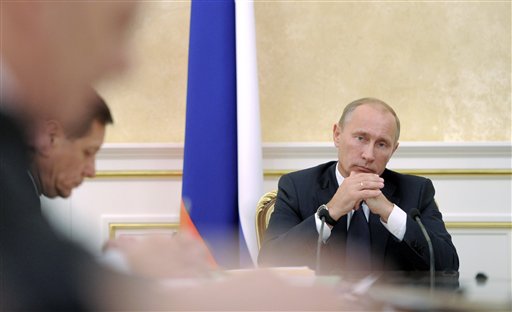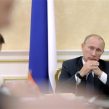
Putin’s Eurasian Manifesto Charts Russia’s Return to Great Power Status
Publication: Eurasia Daily Monitor Volume: 8 Issue: 185
By:

Russia’s prime minister and president-in-waiting, Vladimir Putin, has published a lengthy manifesto on integrating the “post-Soviet space” economically around Russia (“New Integration Project for Eurasia: The Future Is Being Born Today,” Izvestiya, October 4). The publication’s immediate context is electoral, but the implementation is already underway, and the thinking behind it is deeply rooted. The Kremlin regards such integration as a resource-multiplier for Russia, the basis for turning Russia into one of the centers of power in a world of continental-scale blocs.
Putin’s integration project takes the form of concentric circles of Russian dominance and influence, in Eurasia and beyond. As the driving force in the Single Economic Space from 2012 onward (see below), Russia proposes to advance from that integration core to a Eurasian Economic Union, ultimately covering most of the post-Soviet space as an “integrated region.” Such a bloc would operate from “joint positions on the issues facing our region,” with Russia “coordinating” these joint positions.
At the center of a Eurasian Economic Union, Russia would gain a status co-equal with that of the European Union (Putin speaks of European Union-Eurasian Union parity status, but means European Union-Russia parity). Russia would then “function as a nexus between Europe and a dynamic Asia,” whereby “nexus” must be read as balance-holder, for a Europe that Putin declines to dignify as “dynamic.”
Russia would go on to initiate the formation of a free trade zone, eventually an “economic community from the Atlantic to the [Russian] Pacific,” aiming to encompass the Russian-led Eurasian Union and the European Union. This could evolve toward “even more advanced forms of integration, such as single industrial, technology, and energy policies.” This space would be economically coordinated but politically “polycentric.” Putin’s construction (if achieved) would elevate Russia to a special position by the default of others, as Russia alone would still operate as a fully sovereign single-actor in this construction.
Such pooling of resources would in turn enable Russia to act as “one of the poles of the contemporary world,” according to Putin. “This partnership system of the Eurasian Union with the European Union can create real prerequisites for changing the geopolitical and geo-economic configuration on the entire [Europe-Eurasia] continent, with clearly positive consequences on the global level.” Putin’s “positive global” consequences imply a process of de-aligning Europe from the United States.
This message is consistent with Moscow’s appeals to West-Europeans (via Germany and France) to join with Russia in an economically integrated “Greater Europe” or “Europe-Eurasia.” The Kremlin was promoting this concept in Western Europe as a geopolitical project, well before the economic crisis had hit. Europe’s crisis lent this concept the veneer of a long-term solution to Western Europe’s own problems. When addressing West-European audiences with this offer, however, Russia spoke on its own behalf, barely alluding to a Russian-led Eurasian bloc as a collective partner to the EU, and never emphasizing such a bloc.
Putin’s October 4 manifesto suddenly shifts the emphasis markedly in this regard. With ex-Soviet Eurasia now his target audience, Putin describes a Russian-led Eurasian Union as collective participant in Russia-Europe integration processes. Russia, however, positions itself clearly at the center of initiatives and of planning in this regard.
This implies, first, that Russia would wish to deal with the EU from the position of a post-Soviet Eurasian bloc leader, maximizing its own negotiating leverage. Second, that Russia would want these states to deal with Europe through this bloc, i.e. via Moscow, instead of dealing with Europe directly in their national capacities. And thirdly, it tries to imply that these states could more effectively access European technologies and markets (including energy markets) through a Eurasian Union.
Europe’s trans-Atlantic connection with the United States is never mentioned in Putin’s vision of a re-ordered Europe-Eurasia. This economic re-ordering is meant to de-couple Europe from the US politically – a permanent goal of Russian policy in Europe. These are the over-arching strategic implications of Putin’s Eurasian Union manifesto. Almost everything else below this level is matters of technical process.
As Putin outlines it, the process that started with the Russia-Belarus-Kazakhstan Customs Union (signed in 2009, operating as a free trade zone since July 1, 2011) would advance to the Single Economic Space of the same three countries (implementation starting on January 1, 2012), potentially to add other former Soviet-ruled states. Of these, Ukraine constitutes Russia’s prime target. Putin’s text never mentions Ukraine but alludes to it (and apparently Moldova): “Some explain their unwillingness to participate in advanced integration processes in the post-Soviet space by claiming that this contradicts their European choice. I regard this as mendacity.”
The Single Economic Space promises free movement of goods, services, capital, and labor, as well as unified legislation on “internal” trade, competition policy, transportation tariffs on energy and goods, and general access to state procurement orders and contracts (implying access to Russia’s state procurement business as bait for smaller member states). The Single Economic Space would then evolve into a full-fledged Eurasian Economic Union. This exists as EurAsEc since 2001, largely as a symbol, but has established a crucial precedent in Moscow’s favor. Decisions are made through weighted voting, proportionate to each state’s economic power; not through equal voting, let alone consensus.
Moscow describes the Customs Union (operational), Single Economic Space (soon operational), and the Eurasian Economic Union (to be operationalized via the Single Economic Space) as “supranational amalgamations [obedineniya].” According to Putin, “supranational structures are the defining characteristic [printsipyalnaya osobennost] of the Customs Union and Single Economic Space,” en route to a full-fledged Eurasian Economic Union.
According to the Russian government’s chief spokesman, Dmitry Peskov, the publication of Putin’s text was not coordinated with Belarus, Kazakhstan, or any partner state. The Russian leader did not consult any counterparts; he simply purports to speak on their behalf (Kommersant, October 5).




